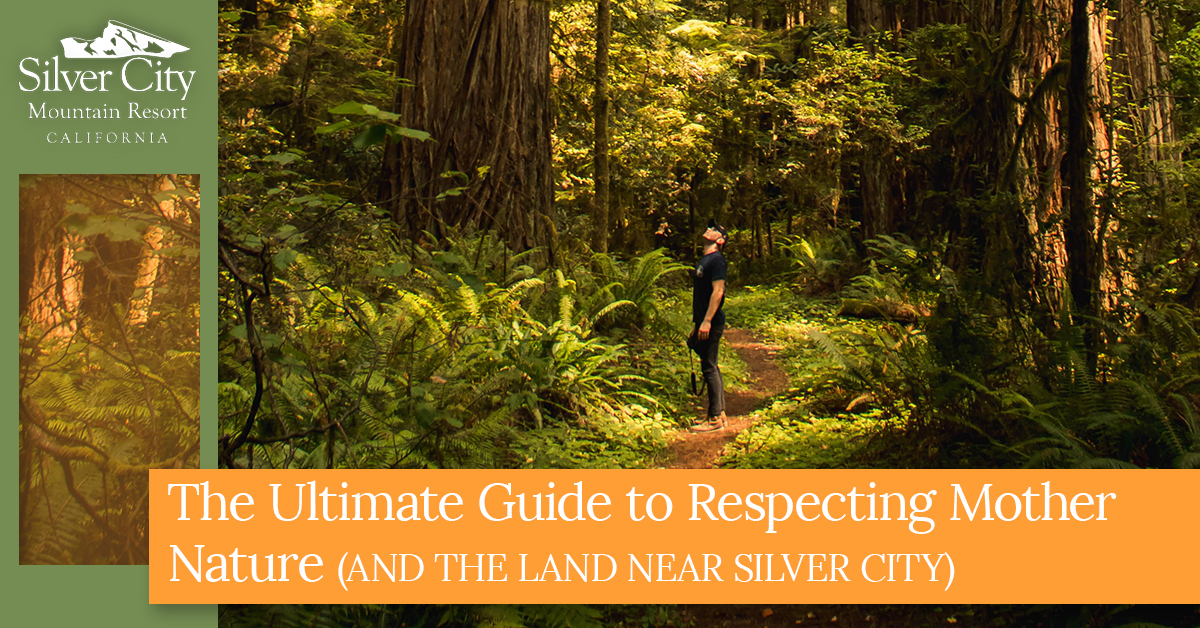

The Ultimate Guide To Respecting Mother Nature (And The Land Near Silver City)
Posted on March 16, 2020 in
Enjoy the outdoors. Respect the outdoors!
One of the highlights of Silver City Mountain Resort is the natural beauty that abounds — from towering sequoias and white fir to sugar pine and chaparral — there is a fresh dose of Mother Nature everywhere you turn.
Embrace the great outdoors when you hunker down with us at Silver City Mountain Resort. We have the best in glamping — with amazing luxury cabins for a quick getaway, or for special events such as weddings, family reunions, and anniversary celebrations. Learn more about outdoor ethics in today’s post.

Outdoor Ethics in Silver City
It’s important to respect the land if you decide to take any day hikes when you stay with us — it preserves nature and wildlife habitats so that others can enjoy it too. Sometimes outdoor ethics make total sense and sometimes we don’t realize what we’re doing is damaging the environment, which is why we’ve put together this guide.
Follow along and learn recommended tips for practicing outdoor ethics when you’re exploring the great outdoors.
 Leave No Trace
Leave No Trace
The leave no trace adage is a framework for anyone venturing outdoors that set into place a set of seven principles that create the least amount of impact on the outdoors and fosters preservation. These guidelines can be practiced anywhere outdoors — from backcountry and skiing to hiking and trail running.
Let’s explore these seven principles more in-depth so you can respect the outdoors and know the best practices when you adventure around the Silver City area.
Not sure where to hike? We’ve written on some of the best hikes including:
- 8 Tips To Prepare For Your Paradise Ridge Hike
- The Ultimate Guide To Sequoia Country (Part One)
- The Ultimate Guide To Sequoia Country (Part Two)
Now, onto outdoor ethics!
 Prepare and Plan
Prepare and Plan
As adventurers, we like to fly by the seat of our pants, which doesn’t always leave a lot of room to prepare. Sometimes we see a sign for a hike and decide right then and there to go for it. And while for most easy hikes, this may not be an issue, it’s always important to pause for a moment and ensure you’re prepared for what’s at hand.
Plan a little. Do some research and see what the hike is like. What’s the difficulty and what are your surroundings like? It’s easy to find yourself in trouble when you’re hiking without water on a hot day in the California high country.
So, before you go, plan and prepare a few things such as water and food and work from there. Pack a day pack, and consider a jacket or rain protection, hat, sunscreen, etc. Having what you need can make the hike so much more enjoyable!
 Respect the trail.
Respect the trail.
The trail was created as a path for you to follow on your hike, and when you veer off trail can damage the land and waterways, so it’s important to be mindful of your travel. When people travel off the trail it can trample fragile vegetation and organisms that may not be able to recover, and sure, one person may not ruin it, but if everyone traveled off-trail, it endangers the land quite significantly.
 Another reason to stay on the constructed trail is to avoid developing multiple routes that can further cripple the land. Trail use is always recommended and it’s important to stay on the width of the trail and bypass switchbacks or walking just outside of the trail.
Another reason to stay on the constructed trail is to avoid developing multiple routes that can further cripple the land. Trail use is always recommended and it’s important to stay on the width of the trail and bypass switchbacks or walking just outside of the trail.
If you do have to travel off-trail — to use the bathroom or to access a remote area that doesn’t necessarily have a constructed trail — there are a few guidelines to consider.
Surface - The surface of the ground is vital to consider when traveling off-trail. A surface that is abundant in large rocks, gravel, or even sand, are going to be quite hardy and can withstand people trampling around, however, muddy, wet conditions can cause a good deal of damage to the land, so it’s advised to stay off this terrain.
Group size - If you have a large group venturing out, it may be worth it to make sure there isn’t a limitation. The mass amount of people all at once can be damaging to the land if people are trying to walk next to each other and make room, stepping off-trail. If you are in a large group and traveling off-trail, make sure the surface is dense and healthy (not wet, snowy, or muddy) and try to be as careful navigating it with more people.
 Learn more about outdoor ethics!
Learn more about outdoor ethics!
While outdoor ethics are uncomplicated, it’s good to get an idea of how to respect the land, to preserve the environment! There’s more to cover, so stay tuned for part two!
An adventure at Silver City Mountain Resort awaits! Book your spot today!

